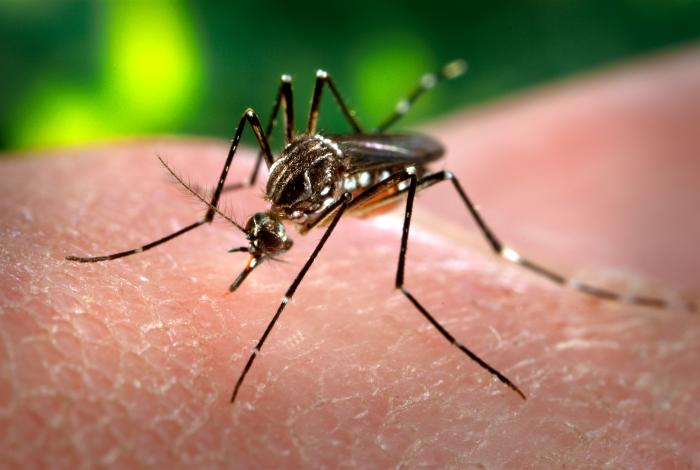

Recently, a new viral outbreak in South America has been getting some attention. It’s called the Zika virus, and it’s spread throughout the continent over the past two years. While scientists work to understand just how the disease affects the body, the virus continues it’s northward march: After appearing in Puerto Rico at the end of December, the first case of Zika was just diagnosed on the mainland U.S., near Houston, Texas.
Until a few months ago, you might have never run across the name “Zika.” The virus is named for the Zika forest in Uganda where scientists first identified it in 1947.
Since then, scientists have figured out the basics for how the virus works. Zika spreads through mosquito bites, with symptoms like fever and joint pain that usually appear a few days later. Because of how it spreads and the nature of these symptoms, Zika is often compared to dengue fever, also called “breakbone fever.” But Zika is generally milder—only about one fifth of patients develop any symptoms, and most who do are back to normal within a week. So far, Zika has not caused any deaths. There’s no specific treatment or vaccine for Zika; those infected usually just need to take aspirin, drink water, and get lots of rest.
Researchers, however, have recently found a new, disturbing side effect. In October, epidemiologists studying the current outbreak in Brazil noticed a higher incidence of microcephaly, a rare neurological condition in which babies are born with smaller than normal heads and underdeveloped brains. Microcephaly is usually rare, but in some areas where Zika was particularly common, the condition was popping up many more times than it had in previous years–Brazil public health officials reported that in 2015, 3,000 babies were born with the condition, compared to 20 the year before. They noticed more babies with microcephaly were born to mothers infected with Zika, even if they didn’t show any symptoms.
Researchers are still not certain how Zika is triggering the increased incidence of microcephaly. But the connection is causing panic—so much so that the Brazilian government recently told women in the country’s northeast, where the epidemic has hit hardest, not to get pregnant for fear of these birth defects.
If scientists have known about Zika for nearly 70 years, why is this the first time they have found a connection between the disease and microcephaly?
For one thing the outbreak, going on for two years in South America, is by far the largest Zika epidemic researchers have ever seen. While individual cases have popped up all over the world, previous outbreaks, in 2007 and 2013, have been limited to a few thousand inhabitants on small islands. “We can’t see the same effects from such a small scale,” says Marie-Claire Paty, an epidemiologist specializing in vector-borne diseases at the French Institute for Public Health Surveillance in Paris. “The difference is that in South America, this is a big outbreak with a lot of inhabitants exposed to risk.”
Studying a disease like this in a lab, Paty adds, is very different from seeing its effects in real world-scenarios. Not only would researchers never think to look at the virus’ effects on pregnant women, studying it in the lab would be ethically fraught.

Outbreaks of mosquito-borne viruses—like Zika and chikungunya—seem to be happening because of globalization. Simply put, it’s become easier than ever for people to travel the globe, and the same goes for diseases. There’s debate about how Zika arrived in Brazil, but some experts think a mosquito, hitching a ride on an airplane, brought it during the massive arrival of fans to the 2014 World Cup. Global warming, of course, also seems to play a role, expanding the range at which mosquitos and other disease-carrying insects, like ticks, can live comfortably.
What’s the outlook?
The epidemic will likely continue for the foreseeable future, spreading around South and Central America and the Caribbean over the next few months, Paty says. The previous smaller outbreaks, which took place on two islands in the Pacific (Yap, in Micronesia, and in French Polynesia), ended when a large proportion of people had developed immunity after being infected, Paty adds. But with a much larger population at risk, that might not be what curbs the outbreak this time.
Without a vaccine available, officials are working to prevent more infections by warning at-risk populations about Zika. Epidemiologists like Paty will be carefully tracking its trajectory to learn more about how it spreads; other scientists will investigate the connection between Zika and microcephaly.
For now, experts have more questions than answers. That will likely put American officials on edge as Zika makes its way into Puerto Rico and the mainland U.S. (the patient recently diagnosed in Texas likely contracted the disease when traveling in South America). The Centers for Disease Control (CDC), as well as public health agencies in other countries, suggests that people in places where Zika virus has been reported take care to prevent mosquito bites by using insect repellant, wearing long sleeves, and staying in places with air conditioning or screens on windows and doors.
